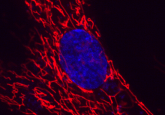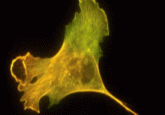Ta-dA! New mitochondrial gene editing development achieves A–G base conversion

Scientists use a single strand DNA-targeting protein for A–G base conversion, in a significant mitochondrial gene-editing technological breakthrough.
There is an unfortunate probability that somewhere in the world today someone will walk up to someone else and, in a bemusing display of unwarranted confidence, assure them that, were they to reorder the alphabet, they would move the letters ‘U’ and ‘I’ together. It is also probable that the recipient of this dramatic hypothetical gesture will roll their eyes at the fumbling Lothario and leave.
Turn your attention, then, to the researchers at the Center for Genome Engineering within the Institute for Basic Science (Daejeon, South Korea), whose confidence is more than well deserved, having managed a singular feat of mitochondrial base pair conversion that is not only worth taking note of, but represents a significant step forward in the development of gene-editing technology.
The novel gene-editing platform, transcription activator-like effector-linked deaminases (TALED), has allowed the researchers at the Center for Genome Engineering to achieve what was previously thought to be impossible: the base conversion of A into G in a mitochondrial genome.
This marks another significant step in the decades-long progression of gene-editing technology. Beginning in 1968 with the identification of the first restriction enzyme, followed by the introduction of the polymerase chain reaction – or PCR – in 1985, it would take until 2013 for CRISPR technology to be demonstrated.
Mitochondrial genome editing has proven to be a difficult obstacle for science, while nuclear genome editing has been demonstrably more successful. TALED utilized the protein TadA8e to achieve the A–G base conversion. This is significant because while mitochondria possess double-stranded DNA, TadA8e is specific to single-stranded DNA.
“No one has thought of using TadA8e to perform base editing in mitochondria before, since it is supposed to be specific to only single-stranded DNA. It was this thinking outside of the box approach that has really helped us to invent TALED,” enthused Kim Jin-Soo, director of the Center for Genome Engineering.
 Researchers use CRISPR gene editing to uncover potential HIV treatments
Researchers use CRISPR gene editing to uncover potential HIV treatments
86 genes that could be associated with HIV replication and pathogenesis have been identified, opening doors to understanding how the virus behaves in the body.
Base editing involves converting one single-nucleotide base to another whilst preserving the DNA in the process. Until now, researchers have used the Broad Institute of Harvard and MIT (both MA, USA) created DddA-derived cytosine base editors (DdCBEs), which allow for mitochondrial C–T conversions. Whilst DdCBEs have been instrumental in gene-editing research, they have been effectively limited to TC–TT conversions, in turn restricting the number of corrections that could be made to mitochondrial mutations to just 10% of the known total. With the introduction and implementation of A–G conversion, the potential number of possible corrections vaults to 43%.
“There is a dearth of animal models of these mitochondrial diseases,” explained Kim. “This is because it is currently not possible to engineer mitochondrial mutations necessary to create animal models.”
Mitochondrial DNA (mtDNA) editing is an important progression. Mitochondria-originating DNA mutations are the basis for a number of severely debilitating hereditary diseases, including, but not limited to, mitochondrial encephalomyopathy with lactic acidosis and stroke-like episodes – a condition that attacks a patient’s brain over time. At present we know of 90 mutations specific to mitochondrial DNA that are responsible for diseases. Several studies have also suggested that Alzheimer’s and muscular dystrophy are connected to aberrations in mitochondrial DNA.
The researchers have already demonstrated their technology, creating a single cell-derived clone with specified edits to mtDNA, with no mtDNA instability and minimal off-target effects caused by the TALEDs. The TALEDs were also noncytotoxic and caused no harmful off-target editing in the nuclear DNA. The researchers now seek to further polish the TALEDs by honing the efficiency and specificity of its editing capabilities. They eventually aim to reach the ability to correct harmful mutations across all ages, from embryos to adults, and also want to develop TALEDs for use in photosynthesis-important chloroplast DNA in plants.





